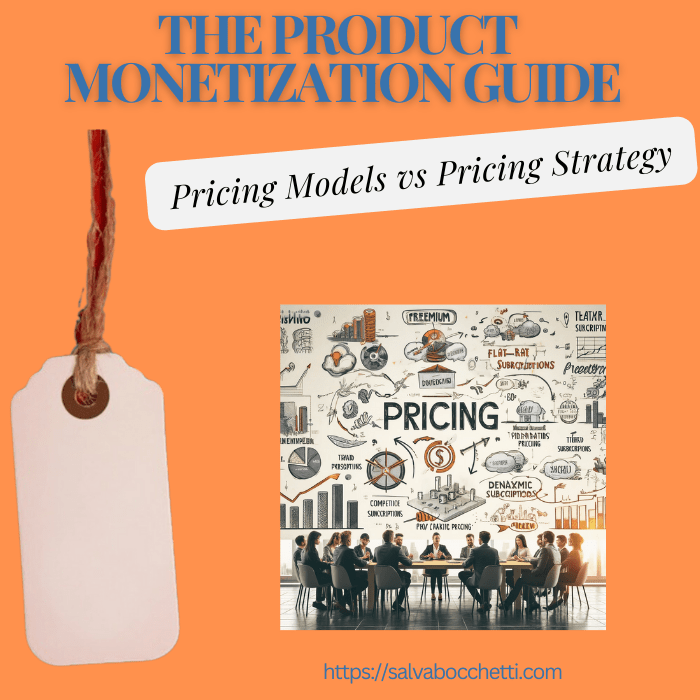Product Monetization Guide: The Pricing Model (vs Pricing Strategy)
Pricing is one of the most important features of your products, representing a significant part of how your customers interact with your company and products. With pricing strategies, pricing models include many elements that, when defined consistently, constitute the pricing of your products.
I have already written a full article about pricing strategies called “Product Monetization Guide: The Pricing Strategy“which I suggest you read first. In this article, we will explore what pricing models encompass and review a few examples of pricing models.
Before we dive in, let’s ensure we understand the differences. While pricing models and strategies are often used interchangeably, they represent distinct aspects of pricing that serve different purposes.
If you’re looking for a quick way to understand the difference, consider it this way:
- Pricing Strategies are how YOU think about your pricing.
- Pricing Models are how your CUSTOMER thinks about your pricing.
Ok, let’s be a bit more specific:
Pricing Strategy involves the methodologies and rationale behind how you set your prices. This includes starting from your overall pricing goals and figuring out the best course of action to deal with market demand, competitor pricing, cost of production, and so on. It is essentially about your approach to pricing, including the principles and calculations used to arrive at the prices presented in your pricing models. It’s a broader approach that ensures your pricing decisions support your company’s financial health and competitive positioning. Some alternatives you can choose from include Cost+ Pricing, Value-based Pricing, and Skimming Pricing. For a full review, have a look at my article Product Monetization Guide: The Pricing Strategy
Pricing Models, on the other hand, are external-facing and concern how customers perceive and understand the prices of your products or services. These models are essentially the packaging of your pricing, tailored to appeal to your target market and align with their expectations and needs. This includes the way your offering “looks,” the value unit (what you charge for), and how you deal with different customers and their perception of your value (including discounting and fencing). At this stage, I suggest you look at the “Product Monetization Canvas” and identify the three main ingredients of the pricing model: Pricing Architecture, Value Unit, and Discounts.

Now, let’s explore some common pricing models used in SaaS, each with its unique approach to attracting and retaining customers. While the number of combinations of pricing architectures, discounts, and value units is almost infinite (and so are the different pricing models), below you will find a summary of common categories:
Pricing models are crucial for how customers perceive and interact with your products. Here, we explore common pricing models used in SaaS, each with its unique approach to attracting and retaining customers. While the combinations of pricing architectures, discounts, and value units are almost infinite, below is a summary of common categories:
1. One-off Pricing
One-off pricing involves charging a single, upfront fee for a product or service. This model is straightforward and is often used for non-recurring services or products with a one-time purchase.
2. Time-Based Pricing
Time-based pricing charges customers based on the duration they use the service. This model is often used in industries where services are rendered over a period, such as coworking spaces, consulting, or cloud computing resources. It ensures that customers pay in proportion to the time they benefit from the service.
3. Flat-Rate Subscriptions
Flat-rate subscriptions involve charging a fixed fee at regular intervals (monthly, yearly) for access to the service. This model provides simplicity and predictability for customers and is widely used in various SaaS applications like streaming services, productivity tools, and more.
4. Tiered Subscriptions
Tiered subscriptions offer multiple pricing levels with varying features and benefits. Each tier targets different customer segments based on their needs and willingness to pay. This model allows businesses to cater to a broader audience, from budget-conscious users to those seeking premium features.
5. Freemium
The freemium model offers a basic version of the product for free while charging for premium features. This model is effective for attracting a large user base quickly, allowing users to experience the value of the product before committing to a paid version. It’s particularly popular in software and digital services.
5. Pay as You Feel/Pay What You Want
In this model, customers choose how much they want to pay for the service. It’s often used for products or services with a strong ethical or community focus. While risky, it can build strong customer loyalty and trust if customers perceive the value they receive as high.
6. Bulk Pricing
Bulk pricing provides discounts for purchasing larger quantities of a product or service. This model encourages higher volume purchases and is often used in software licenses, cloud storage, or any service where scaling up usage provides added value to the customer.
7. Volume-Based Pricing
Volume-based pricing consists of charging your customers based on the volume of your product that they purchase (data, CPU power,…) and, maybe coupled with bulk pricing to offer discounts based on the amount of usage. It’s common in data services, telecommunications, and cloud computing.
8. Dynamic Pricing
Dynamic pricing adjusts prices in real time based on demand, market conditions, and other factors. It is commonly used in industries like travel, entertainment, and e-commerce to maximize revenue and manage supply and demand effectively.
9. Market Pricing
Market pricing sets prices based on the current market conditions, including competitor prices, market demand, and economic factors. This model ensures that prices are competitive and aligned with market expectations.
10. Bundle Pricing
Bundle pricing offers a set of products or services together at a discounted rate compared to purchasing each item separately. This model encourages customers to buy more by providing perceived value and convenience.
While pricing strategies and pricing models are distinct concepts, they are interconnected and should complement each other to achieve your business objectives. A well-defined pricing strategy can guide the selection of appropriate pricing models that support and enhance your overall pricing approach.
For instance, if you have decided to follow a competition-based pricing strategy, where your prices are set in relation to your competitors, market pricing can be an effective supporting model (whether you price above or below the pricing of your competition is another story, and is a matter of your positioning strategy). This approach ensures your prices remain competitive and aligned with market conditions. However, market pricing is not the only option; other models like dynamic pricing can also support this strategy by adjusting prices in real time based on market dynamics.
Similarly, if you have chosen a penetration pricing strategy to enter a market with low prices to attract customers quickly, several pricing models can support this approach. Bundling offers customers a package of products or services at a discounted rate, increasing perceived value. Flat-rate subscriptions provide simplicity and predictability, making it easier to attract price-sensitive customers. These models help implement the penetration strategy effectively, although they are not the only possible choices.
By understanding the relationship between your pricing strategy and the available pricing models, you can create a coherent and effective pricing framework. This alignment ensures that your pricing decisions not only meet your internal business goals but also resonate with your customers, fostering trust, loyalty, and long-term success.
If you’re looking for an easy way to work with your team or visualize all these concepts, I suggest that you give a try to the free Product Monetization Canva, available among the pricing resources at this link

My name is Salva, I am a product exec and Senior Partner at Reasonable Product, a boutique Product Advisory Firm.
I write about product pricing, e-commerce/marketplaces, subscription models, and modern product organizations. I mainly engage and work in tech products, including SaaS, Marketplaces, and IoT (Hardware + Software).
My superpower is to move between ambiguity (as in creativity, innovation, opportunity, and ‘thinking out of the box’) and structure (as in ‘getting things done’ and getting real impact).
I am firmly convinced that you can help others only if you have lived the same challenges: I have been lucky enough to practice product leadership in companies of different sizes and with different product maturity. Doing product right is hard: I felt the pain myself and developed my methods to get to efficient product teams that produce meaningful work.

